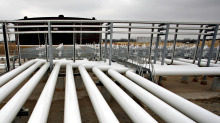Rush to build pipelines aimed at breaking crude logjam
 For Alberta’s energy industry, Enbridge Inc.’s plan to build a pair of major pipelines through the heart of North America promises to help break an export logjam that has severely discounted the value of crude surging from the oil sands.
For Alberta’s energy industry, Enbridge Inc.’s plan to build a pair of major pipelines through the heart of North America promises to help break an export logjam that has severely discounted the value of crude surging from the oil sands.At a cost of $3.8-billion, the Enbridge new pipes won’t be cheap. But for Canadian oil producers, that amount pales in comparison with what they are losing – by one estimate, $18-billion a year – as an export bottleneck weighs on prices for Canadian oil.
A shortage of capacity for moving oil out of the oil sands has stirred a broad rush to build new pipelines to all points of the continent – Kitimat, B.C., Quebec City, Houston.
The battle to build new pipes comes as energy companies seek to gain back some ground, after more than a year of “taking the short end of the stick … simply because we can’t move product,” said Lowell Jackson, chief executive officer of WestFire Energy Ltd. and chairman of the Canadian Association of Petroleum Producers.
He pointed to the delays in the Keystone XL pipeline project as one reason companies are interested in numerous pipeline projects.
“The way the things are being held up in the regulatory process, you have to say, ‘Hey we can’t just be betting on one thing here,’” Mr. Jackson said. “You have to cover all your bases.”
The most important destination is the Gulf Coast, home of the world’s largest refining complex, and a short distance from Cushing, Okla., the major crude oil hub that has seen such a glut of product that North American prices have been trading $20 (U.S.) a barrel below international values.
The Enbridge proposals – the 585,000-barrel-a-day Flanagan South pipe to Cushing from Flanagan, Ill., near Chicago; and a twinned Seaway pipeline system that would move 850,000 barrels from Cushing to near Houston – are coming during a veritable deluge of pipeline proposals.
They include Enbridge’s Northern Gateway, TransCanada Corp.’s Keystone XL, TransCanada’s East Coast pipeline proposal and Kinder Morgan’s plan to expand the Trans Mountain system. Add to that the roughly 450,000 barrels of slack capacity on current Enbridge pipe, plus the company’s ability to add pumps to push more oil through pipes, and a remarkable three million barrels a day of new pipeline capacity is being contemplated.
Between now and 2020, the Canadian Association of Petroleum Producers expects Canadian oil output to grow by 1.4 million barrels a day. Even if the Bakken play in the northern United States were to grow by one million barrels a day during that time (an optimistic view, given some believe it will only grow by 400,000), it’s clear that the industry is working to build an enormous volume of new pipe.
It is considered counterproductive for energy companies to buy more pipeline space than they need, because that can result in too much capacity, which makes it more expensive to move oil. But the numbers suggest companies are doing exactly that, and for good reason.
Lack of pipeline space has created major problems for Canadian producers. Not only are North American oil prices depressed, but Canadian crude values have fallen far below those levels, thanks to oversupply of crude into Midwestern refining markets. The solution: Build more pipe.
“The shippers never want to be short of pipeline capacity. They’d rather have a little more than not enough,” said Lanny Pendill, an analyst with Edward Jones.
The rush to move oil to the Gulf Coast has not lessened the desire for some executives to send barrels westward, for export to Asia. They want to have more options than “being just a seller … to the U.S.,” as Scott Saxberg, chief executive officer of Crescent Point Energy, put it.
Yet if major new pipes are moving crude south, what will be left to move it west, through projects such as Gateway?
Stephen Wuori, Enbridge president of liquids pipelines, said the company doesn’t believe new pipes will “cannibalize” that project. Instead, Enbridge believes Gateway will be used to spawn production that might not otherwise happen, by providing an avenue to markets with more stable pricing.
“We’ve analyzed that pretty carefully, and we’re very comfortable, based on the production forecast, based on the commitments we have to the Gulf Coast, as well as the commitments we have on Gateway, that we’re not talking about the same barrel being torn in two directions,” he said.
You can return to the main Market News page, or press the Back button on your browser.

